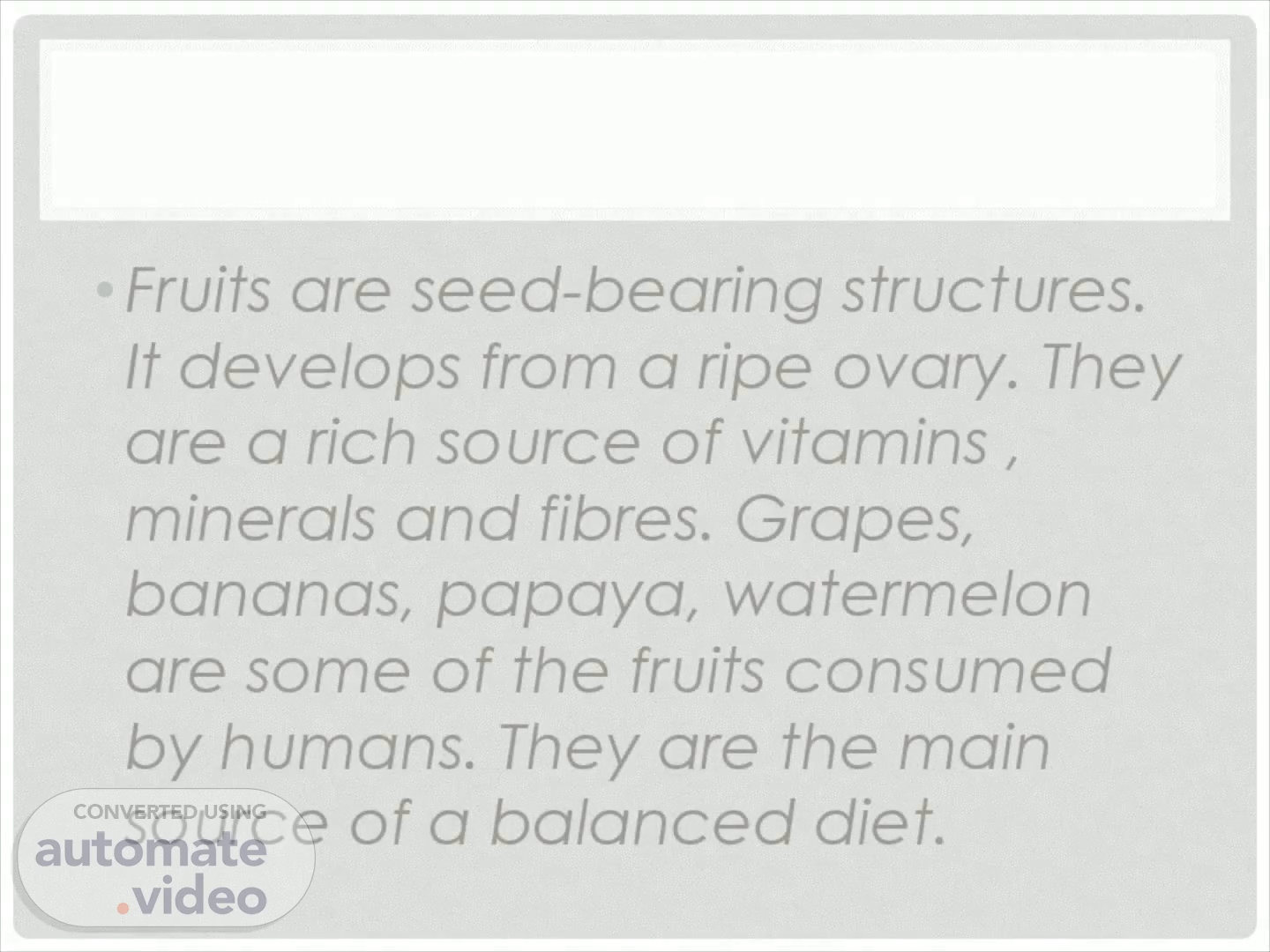Scene 1 (0s)
[Audio] Fruits are seed-bearing structures. It develops from a ripe ovary. They are a rich source of vitamins , minerals and fibres. Grapes, bananas, papaya, watermelon are some of the fruits consumed by humans. They are the main source of a balanced diet.
Scene 2 (22s)
(4 pedice skin flesh seed core.
Scene 3 (27s)
[Audio] Based on the number of ovaries and the number of flowers involved in the fruit formation, fruits are classified into three major groups namely: Simple fruit Aggregate fruit Composite fruit.
Scene 4 (43s)
[Audio] A fruit comprises the following parts: Pericarp Seeds.
Scene 5 (52s)
2 3 8 4 o Endosperm O Endocarp Embryo o Mesocarp 5 6 7 O Seed Coat O Exocarp O Seed Pericarp.
Scene 6 (59s)
[Audio] The pericarp is the wall of the ovary that develops as the wall of the fruits. The pericarp of the fruits might be fleshy as in guava, mango, etc. or might be dry as in mustard, walnut, etc. The pericarp is further differentiated into three layers, namely: Epicarp: Outermost layer, forms the peel. Mesocarp: Middle layer, fleshy, edible portion of the fruits Endocarp: Innermost layer, the inner rough portion where the seed is accommodated.
Scene 7 (1m 34s)
[Audio] These fruits develop from a single matured ovary in a single flower. Apple, banana, cherry pear are few examples of simple fruits. The simple fruits are classified into the following categories: Drupes: These are also known as stone fruits since it contains a very hard seed inside the simple fruits. For eg., plum, cherry, peach. Berries: These type of fruits have a single seed in the center and are very juicy. For eg., grapes, blueberries. Pomes: Such fruits bloom from trees. For eg., apple, papaya Hesperidium and Pepos: They are slightly similar to the berries and include fruits such as watermelon, citrus fruits..
Scene 8 (2m 29s)
[Audio] These fruits develop from a number of matured ovaries formed in a single flower. Individual ovaries are called "fruitlets." Blackberry, raspberry, strawberry are few examples of aggregate fruits. Aggregate fruits make a bunch of fruitlets which are known as etaerio..
Scene 9 (2m 50s)
[Audio] Etaerio of berries: Annona is Etaerio of berries. In the etaerio of Annona, all the berries are arranged on the thalamus. Etaerio of drupes: In Etaerio of drupes, many small drupes develop from different carpels. Example: Raspberry. THALAMUS : a platform in which a ovary develops into a fruit . CARPEL: ovule bearing female reproductive part.
Scene 10 (3m 26s)
[Audio] Etaerio of follicles: In this type, the stigma is fused or joined in the carpellary ovary, and ovaries of ovules are separated like in Calotropis[ algae]. Etaerio of achenes: Strawberry and Lotus are Etaerio of achenes. In lotus, the thalamus is spongy and some achenes are embedded in it.
Scene 11 (3m 51s)
CARPELLARY OVARY.
Scene 12 (3m 57s)
[Audio] These fruits develop from a complete inflorescence[complete flower] , these are also known as multiple fruits. Composite fruits are of two types: Sorosis: These are found in mulberry, jackfruits and pineapple. They develop from catkin, spikes and spadix type of inflorescence. Syconus: This develops from hypanthodium type of inflorescence.
Scene 13 (4m 25s)
[Audio] Fruits are rich in vitamins and minerals which are essential for a healthy human body. For instance, we know that oranges are rich in vitamin C. Vitamin C is vital to neutralize any free radicals in our body Fibre-rich fruits like raspberries are very good for digestion. The protein in papaya, called papain, can help the breakdown of proteins, and therefore aid digestion. Palm dates have a low glycemic index and hence, they are very useful in blood sugar regulation. Furthermore, it is high in dietary fibre and is very helpful for digestion..
Scene 14 (5m 8s)
PREPARED BY: SHUBHAM ADHIKARI GRADE XI[11].
